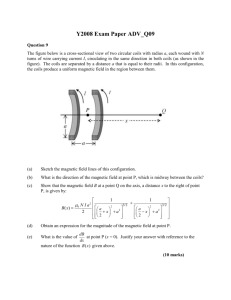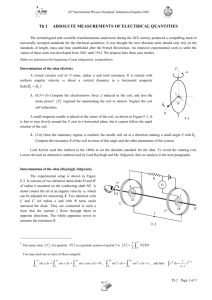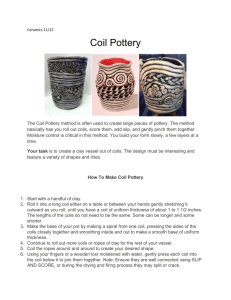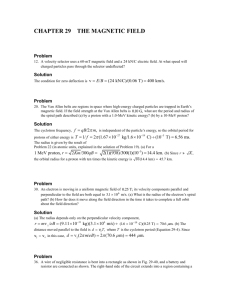V. Overview Of The Detected Shorts - HAL
advertisement
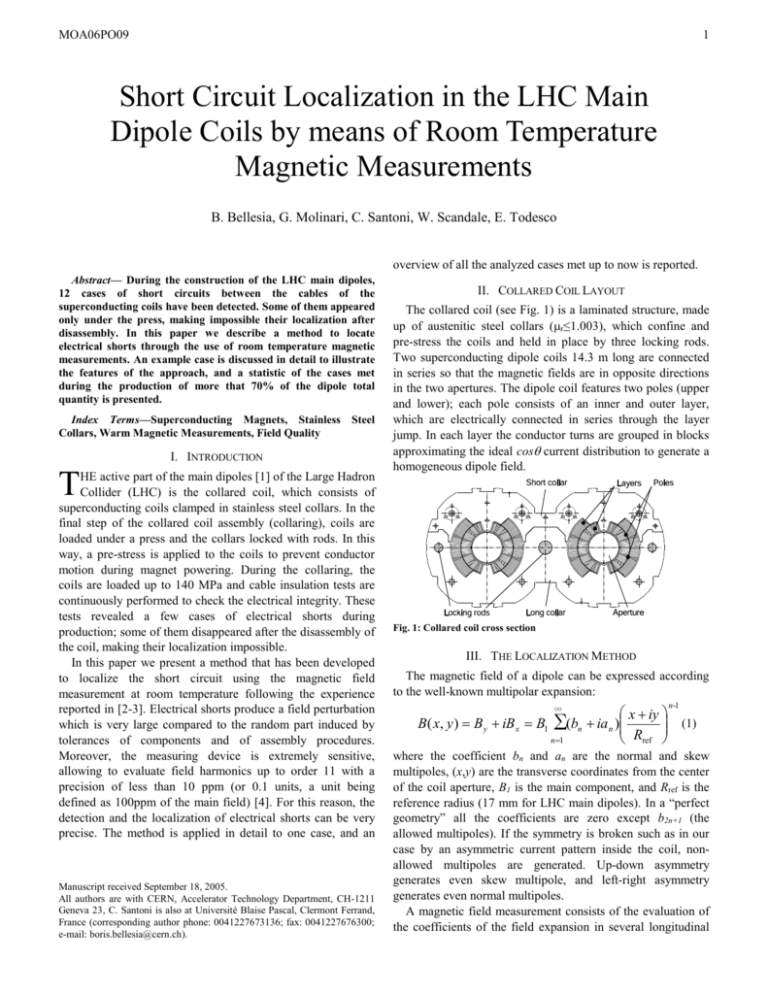
MOA06PO09 1 Short Circuit Localization in the LHC Main Dipole Coils by means of Room Temperature Magnetic Measurements B. Bellesia, G. Molinari, C. Santoni, W. Scandale, E. Todesco overview of all the analyzed cases met up to now is reported. Abstract— During the construction of the LHC main dipoles, 12 cases of short circuits between the cables of the superconducting coils have been detected. Some of them appeared only under the press, making impossible their localization after disassembly. In this paper we describe a method to locate electrical shorts through the use of room temperature magnetic measurements. An example case is discussed in detail to illustrate the features of the approach, and a statistic of the cases met during the production of more that 70% of the dipole total quantity is presented. Index Terms—Superconducting Magnets, Stainless Steel Collars, Warm Magnetic Measurements, Field Quality I. INTRODUCTION T HE active part of the main dipoles [1] of the Large Hadron Collider (LHC) is the collared coil, which consists of superconducting coils clamped in stainless steel collars. In the final step of the collared coil assembly (collaring), coils are loaded under a press and the collars locked with rods. In this way, a pre-stress is applied to the coils to prevent conductor motion during magnet powering. During the collaring, the coils are loaded up to 140 MPa and cable insulation tests are continuously performed to check the electrical integrity. These tests revealed a few cases of electrical shorts during production; some of them disappeared after the disassembly of the coil, making their localization impossible. In this paper we present a method that has been developed to localize the short circuit using the magnetic field measurement at room temperature following the experience reported in [2-3]. Electrical shorts produce a field perturbation which is very large compared to the random part induced by tolerances of components and of assembly procedures. Moreover, the measuring device is extremely sensitive, allowing to evaluate field harmonics up to order 11 with a precision of less than 10 ppm (or 0.1 units, a unit being defined as 100ppm of the main field) [4]. For this reason, the detection and the localization of electrical shorts can be very precise. The method is applied in detail to one case, and an Manuscript received September 18, 2005. All authors are with CERN, Accelerator Technology Department, CH-1211 Geneva 23, C. Santoni is also at Université Blaise Pascal, Clermont Ferrand, France (corresponding author phone: 0041227673136; fax: 0041227676300; e-mail: boris.bellesia@cern.ch). II. COLLARED COIL LAYOUT The collared coil (see Fig. 1) is a laminated structure, made up of austenitic steel collars (r≤1.003), which confine and pre-stress the coils and held in place by three locking rods. Two superconducting dipole coils 14.3 m long are connected in series so that the magnetic fields are in opposite directions in the two apertures. The dipole coil features two poles (upper and lower); each pole consists of an inner and outer layer, which are electrically connected in series through the layer jump. In each layer the conductor turns are grouped in blocks approximating the ideal cos current distribution to generate a homogeneous dipole field. Fig. 1: Collared coil cross section III. THE LOCALIZATION METHOD The magnetic field of a dipole can be expressed according to the well-known multipolar expansion: n-1 x iy (1) B( x, y ) B y iB x B1 ∑(bn ia n ) n 1 Rref ∞ where the coefficient bn and an are the normal and skew multipoles, (x,y) are the transverse coordinates from the center of the coil aperture, B1 is the main component, and Rref is the reference radius (17 mm for LHC main dipoles). In a “perfect geometry” all the coefficients are zero except b2n+1 (the allowed multipoles). If the symmetry is broken such as in our case by an asymmetric current pattern inside the coil, nonallowed multipoles are generated. Up-down asymmetry generates even skew multipole, and left-right asymmetry generates even normal multipoles. A magnetic field measurement consists of the evaluation of the coefficients of the field expansion in several longitudinal MOA06PO09 positions at the center of the aperture along the magnet. For the LHC dipoles, the measurements are performed with a 750 mm long rotating coil in 20 positions: in the 1st and in the 20th position the ends of the coil are included, and the mole enters in the aperture only for 534 mm. Positions 2 to 19 are in the so-called straight part of the magnet coil [4]. When a short circuit occurs, it produces an anomaly in the magnetic field whose signature can be used to detect the short location. The field anomaly is first evaluated and compared to the control limits (i.e. the field range that is expected as “normal” based on previous experience) to single out the affected harmonics. Then, by comparing the measurements with a magnetostatic model the location of the short is identified. A. Computation of the field anomaly The measurement of the magnetic field of the aperture affected by a short is compared to a reference measurement (normally the other aperture of the collared coil), and subtracting the reference from the measurement, one obtains the field anomaly. This procedure is necessary for allowed multipoles, which always have a systematic component, and for measurements carried out under the collaring press, whose iron induces a strong systematic magnetic perturbation on field harmonics (even multipoles in our case). The field anomaly is then compared to the control limits of the production. These have been determined for each multipole by taking ±3.5 times the standard deviation of the population of the collared coils that had no known anomalies [5]. B. Identification of the aperture and the pole An electrical short circuit occurs either in the upper or in the lower pole, and therefore it generates a strong up-down asymmetry. For this reason, the multipole a2 is the most affected by a short circuit. Simulations show that for the LHC dipole coil, an electrical short of two neighboring cables gives 5 to 60 units of a2 which is much larger than the control limit of 3.2 units. The smallest contribution (5 units) is given for shorts close to the mid plane. In this case there is also a strong effect on b3 (45 units) that can also be used to double-check the analysis on a2. The aperture that is featuring a field anomaly in a2 has the electrical short. The sign of a2 is related to the pole localization; if the short is in the upper pole a2 is positive, and if it is in the lower pole a2 is negative. C. Localization of the longitudinal position To analyze the problem we use a simple model: an aperture of two poles made up of a single layer with three cable turns (see for instance the three turn coils of Fig. 2). Let us consider a short circuit in a given longitudinal position along the magnet axis, where the current by-passes an entire turn (dashed line in Fig. 2). A coil cross section taken between the short and the connection side (c.s.) features a current distribution with a left-right asymmetry. On the other hand, a coil cross-section taken between the short and the nonconnection side (n.c.s.) has a left-right current symmetry. This 2 gives a tool to longitudinally locate the short: If anomalies are measured in a given longitudinal position in all the four families of multipoles, the short is between this location and the non connection side; If anomalies are measured in a given longitudinal position in odd normal and even skew multipoles only, the short is between this location and the connection side. For cases of shorts located in one of the coil ends: If the b2n and a2n+1 show no anomaly all along the axis, the short is located in the c.s. end; If the b2n and a2n+1 field harmonics show anomalies all along the axis, the short is located in the n.c.s. end. Therefore, we can locate the short in the magnetic measuring position where the anomaly in even normal and odd skew harmonics falls to zero. The uncertainty in the longitudinal localization is given by the length of the measuring position: 534 mm in the ends and 750 mm in the straight part. (m+1,m) (m-m) (m,m+1) (m+1,m+1) Fig. 2: Simplified model of a coil with two layers of three cable turns; dashed line is the turn bypassed by the current (left). Cross sections of the coils with respect to the short: the crosses indicate that no current is flowing inside the cable (right). D. Localization of the radial position We now proceed with the identification of the radial position in the coil cross section. A simple method can be used to detect if the short is in the inner or in the outer layer, following the approach given in [6]. The principle used is that the field anomaly has a slow decay with the multipole order if the short is close to the aperture (inner layer), and a fast one if it is far (outer layer). Let (bn,an) be the field anomalies measured in the multipoles. According to the Biot-Savart law, the field anomalies linearly decay with the multipole order n as a power law ( Δbn )2 + ( Δa n )2 ≈ A ( Rref n ) Rs (2) where Rs is the unknown distance of the source of the field anomaly from the aperture center. Therefore, we have f ( n ) ≡ln ( Δbn )2 ( Δan )2 ≈ n ln Rref ln A (3) Rs and making a linear fit of the function f(n) f ( n ) ≈ P Qn we can deduce Rs through the fitted slope Q (where Q>0): (4) MOA06PO09 (5) Rs = Rref exp( Q) Since the inner layer is between 28 and 43 mm, if Rs is in this range the short is in the inner layer. Similarly, if Rs is between 43 to 59 mm the short is in the outer layer. E. Identification of the cable inside the coil The convention we use in this note for numbering cables in the coil cross section is shown in Fig. 3, where the upper pole of a LHC aperture is sketched. When a short occurs, an entire turn of the coil is by-passed, i.e., there are two cables in the coil cross section, one on the left and one on the right part, that do not transport any current. From here on, we assume that the short is located in the upper pole of the aperture (all the considerations are also valid for a short in the lower pole, taking care to apply the right symmetries: the effects on b2n+1 and a2n+1 are the same whilst they change sign for b2n and a2n). 3 IV. APPLICATION OF THE METHOD We consider in detail the case of a collared coil that showed no anomalies during the magnetic measurement, where the short appeared later during an insulation test. The short has been detected as a drop of about 30 m of the resistance of the coil in aperture 2, corresponding to a short circuit of one turn. Then, a magnetic measurement of aperture 2 has been repeated, this time showing strong field anomalies. The measurement of aperture 2 before the short has been used as a reference. The anomaly was uniform along the axis, thus suggesting that the location is in the coil end. In Table I we present the field harmonics averaged over the measuring positions of the straight part with and without the short circuit. We evaluate the field anomaly as the difference between these values, and we express them in units of the control limits set on the production. TABLE I FIELD HARMONICS MEASURED IN THE CASES WITH AND WITHOUT SHORT, DIFFERENCE, CONTROL LIMITS OF THE PRODUCTION, EXPECTED FIELD ANOMALY FOR SHORT IN POSITION 34-34 AND DIFFERENCE WITH RESPECT TO MEASUREMENT. Figure 3: Cable numbering for half aperture of a LHC dipole. We define the short circuits that can be detected in a pole. We assume that shorts between inner and outer layer do not happen, and that shorts can appear only among two contiguous cables. Let m be the cable of the right quadrant of the pole which does not transport any current: we denote by (k,l) the couple of cables in the left and in the right part of the coil respectively where no current flows. Therefore, following the considerations done for the simplified pole of Fig. 2, the possible shorts are the following ones: For the inner layer, we have (m+1,m) between the short and the connection side, and (m,m) between the short and the non connection side For the outer layer, we have (m,m+1) for the cross-section between the short and the connection side, and (m+1,m+1) for the short between the short and the non connection side. The two cables that do not transport current create a different current distribution with respect to design; this causes a field anomaly which is strongly dependent on the angular positions () of the cables that are switched off: the effects on b2n+1 and on a2n+1 are roughly proportional to cos[(2n+1)] whilst the ones on b2n and on a2n to sin[(2n)]. We evaluate the field anomalies given by all the possible short circuits using a magneto-static model of the cross section [7]. The largest effects on field quality are observed for short circuits placed in the inner layer, the most affected harmonics being b3 and a2 ([-40 - 40] and [0 - 90] units respectively). By comparing the measured anomaly with the expected effects of all possible shorts we identify the short location in the coil cross-section. Since we are using several multipoles, the solution is always unique. b2 b3 b4 b5 b6 b7 b8 b9 a2 a3 a4 a5 a6 a7 a8 a9 with short 0.15 5.87 0.47 12.44 -0.05 2.22 -0.04 -0.22 89.02 -0.57 15.18 -0.42 -3.15 -0.08 -1.70 0.00 without short -0.69 -5.87 0.02 0.04 0.05 0.79 -0.02 0.45 0.17 -0.48 0.43 -0.17 -0.10 -0.04 0.07 -0.04 0.83 11.73 0.45 12.40 -0.10 1.42 -0.02 -0.66 88.85 -0.08 14.75 -0.25 -3.05 -0.04 -1.77 0.04 Control D/cont. limits limits ±1.82 0.5 ±2.59 4.5 ±0.46 1.0 ±0.70 17.7 ±0.21 -0.5 ±0.22 6.3 ±0.08 -0.2 ±0.05 -12.6 ±2.45 36.3 ±1.12 -0.1 ±0.98 15.1 ±0.46 -0.5 ±0.25 -12.4 ±0.17 -0.2 ±0.08 -21.1 ±0.07 0.6 simul. 34-34 11.89 12.11 1.35 -0.69 88.69 15.37 -3.21 -1.72 - -simul. -0.16 0.29 0.07 0.03 0.16 -0.62 0.16 -0.05 - A. Localization: Aperture and Pole: as already said the fault is in the aperture 2: a2 is more than 30 times out of the control limits. Since the a2 is positive the short is located in the upper pole. Measuring position and layer identification: referring to the sixth column of Table I, where the field anomaly is divided by the control limits set on the production, it is clear that the field anomaly is only on odd normal and even skew multipoles: therefore, the short is in the connection side end corresponding to the first magnetic measurement position. The linear fit of the function f(n) defined in Eq. (4) gives a slope of -0.79 (see Fig. 4), corresponding to Rc = 37 mm, i.e. the short is in the inner layer. Cables identification: The short circuit configuration that minimizes the difference between the measurement and the model is the (34,34), see Figs 5-6 and Table I: expected and MOA06PO09 measured values match within a fraction of unit. The short is placed somewhere within the first magnetic measuring position (connection side end), among the cable 34 and the cable 33 of the inner layer. 4 short have been developed and they have been applied successfully to all the successive cases. In all cases, the location of the short matched the result of the method presented here. The case of 1217 is still open since it has not been disassembled yet. TABLE II MAIN FEATURES OF ALL THE DETECTED SHORTS. Firm Dipole Ap. Pole 1 1 1 1 1 1 1 1 1 2 2 2 1103 1124 1127 1141 1154 1165 1178 1217 1526 2087 2101 2202 1 2 1 1 2 1 1 1 2 2 2 2 U U L U U L L U U U U L Fig. 4: Function f(n) as defined in Eq. (3) versus multipole order n for the field anomaly, and linear fit. Meas. Pos. 1 1 1 1 1 1 1 20 20 1 1 1 Layer I I I I I I I I I I I I Short config. 38-38 38-38 38-38 38-38 38-38 38-38 38-38 38-37 40-39 34-34 34-34 38-38 VI. CONCLUSIONS Fig. 5: Expected and measured (case 2101) field anomalies in a2, b3 versus short circuit position. Fig. 6: Expected and measured (case 2101) field anomalies in a4, b5 versus short circuit position. We have shown that for the main LHC dipoles the magnetic field anomalies generated by electrical shorts are very strong and can therefore be used to locate them. The method presented is based on simulating with an electromagnetic code all the possible shorts, and by comparing the results of the measurements to the simulations. In all cases it has always been possible to find a short location that matches measurements and simulation within 10 to 50 ppm (i.e. a fraction of unit). The short location evaluated in this way has been verified experimentally in the coils that have been disassembled. This approach has allowed the rescue of several superconducting coils during the production of the main LHC dipoles. REFERENCES [1] V. OVERVIEW OF THE DETECTED SHORTS To date, the localization method has been successfully used for 12 cases in two dipole suppliers (9 of Firm 1 and 3 of Firm 2). Data are summarized in Table II: all defects have been localized in the magnet ends, and 10 out of 12 in the connection side, which is the most critical one due to the asymmetry of the assembly. In all cases the short is in the inner layer. The shorts are equally shared among upper and lower poles, and aperture 1 and 2 as expected. Five different locations in the cross-section have been found; we had several cases of short in the cable 38-38. In the first two cases (1103 and 1124), due to the insufficient experience on the problem, it has not been possible to verify the presence of the short where foreseen by the method. These were difficult cases were the short appeared only during the collaring at a given pressure and disappeared after the disassembly of the collared coil. Then, dedicated procedures to have an experimental characterization of the [2] [3] [4] [5] [6] [7] L. Rossi, “Experience with LHC Magnets from Prototyping to Largescale Industrial Production and Integration’’, EPAC 2004, Lucerne, Switzerland, 05 - 09 Jul 2004. P. Komorowski, D. Tommasini,“Localization of electrical insulation failures in superconducting collared coils by analysis of the distortion of a pulsed magnetic field”, LHC-Proj.-Rep.-343, CERN, 1999 A. Jain, talk given at USPAS (2003), see BNL web-site: www.bnl.gov/magnets/Staff/Gupta/scmagcourse/uspas03/AJ03/AJ_ProductionTool.pdf J. Billan et al., “Magnetic measurements of the LHC quadrupole and dipole magnets at room temperature”, LHC–Project Note 283, CERN 2002 E. Wildner, et al., “Production Follow-Up of the LHC Main Dipoles through Magnetic Measurements at Room Temperature,” MT18, Morioka, Japan, 20-24 Oct 2003. S. Pauletta, “Field quality analysis to monitor the industrial series production of the dipole magnets for the Large Hadron Collider”, 2002 Torino, CERN-THESIS-2003-002 B. Bellesia et. al., “Room temperature magnetic field measurements as a tool to localize inter-turns electrical short circuits in the LHC main dipole coil”, to be published as CERN LHC-Project Report


